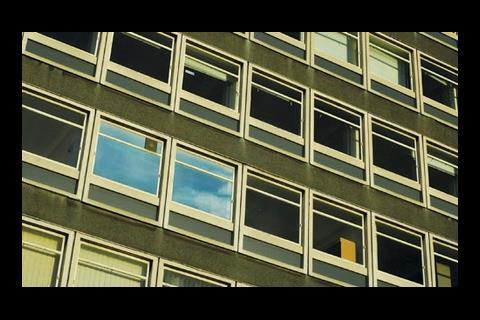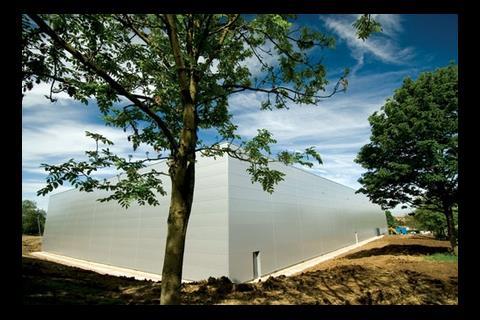David Rees of Davis Langdon reviews the latest thinking on low-carbon design features to improve the energy performance of office buildings
01 / Introduction
Without a great deal of prior publicity, the arrival of energy performance certificates (EPC) earlier this year has resulted in a fairly steep learning curve for the UKŌĆÖs property industry. Owners and occupiers have to establish how they are affected and what the future implications will be, and property professionals need to build a technical understanding of the issues involved. The EPC is an assessment that is intended to be a catalyst for the improvement of low-performing buildings, which with rising energy costs, may well come to be regarded as energy black holes. This article covers what may soon become a commonplace exercise ŌĆō managing performance improvements to an existing commercial property.
02 / The existing building
Davis Langdon was asked by an investment client to review a building that had a planned upgrade project in hand and would need an EPC to enable it to be let.
It was decided to use the opportunity as a knowledge-building exercise in order to understand which changes would have the greatest impact in improving the asset rating. The first stage was an assessment of the building as it stood and, from this, to model possible improvements and individually measure their effect.
The building is a late seventies seven-storey office building located in a south coast town and which was built as an externally-clad concrete frame with single glazed windows. Heating is provided by a gas-fired boiler plant which provides low temperature hot water to a four-pipe fan-coil system and with cooling by separate chiller units.
The initial EPC assessment was undertaken using BREŌĆÖs simplified building energy model software (iSBEM). The assessment involves collating information relating to the construction, fabric, and services of the building, and in particular, how the space is zoned internally.
It is also helpful if there is good information to hand from maintenance manuals on the existing equipment in order to gather accurate data on U-values and efficiencies of the heating, cooling and ventilation plant. However, in an older building particularly without full-time maintenance staff, such documents may be hard to locate or not up to date. This could result in an inaccurate outcome of the energy assessment as it becomes necessary to use the system default setting which reflects the lowest efficiency. In this case it was necessary to contact the maker of the heating system but as the boiler was about 15 years old it was unable to assist.
Once all the information had been assembled and the building surveyed and the internal areas broken into zones, the first result from iSBEM produced an E rating of 109 points. The software output also includes an indication of the benchmark for the building ŌĆ£if typical of the existing stockŌĆØ, on which basis an asset rating of 132 (F) was indicated.
At this stage, it is worth reminding the reader of the asset rating scale ŌĆō which goes from 0 to 150+ in steps of 25, from A+ to G. Therefore, the initial assessment was perhaps better than might have been expected, and to make the minimum step to the next band of a D rating ŌĆō at 100 points or less ŌĆō only a comparatively modest reduction of nine points would be required.
03 / Considering an upgrade pathway
From the clientŌĆÖs perspective, the main objective was cosmetic ŌĆō to update the external envelope to improve the buildingŌĆÖs appeal to potential tenants ŌĆō with reduced energy use being a spin-off benefit rather than the underlying driver. Therefore, the priority in setting the budget would be the facelift, with energy saving measures welcome, providing they did not inflate the capital outlay and threaten economic viability. To this end, the pre-planning of the capital allowances tax reliefs for plant and machinery ŌĆō and the 100% enhanced capital allowances for low carbon, energy saving equipment became a notable benefit in stretching the budget. (1)
In considering the options available to improve energy efficiency, there was also excellent guidance available in the CIBSE/BSRIA guide to refurbishments. (2)
04 / Cladding, glazing, heating and lighting
Cladding
As the building had become dated in appearance, the most important change was to modernise its look, and this was achieved by attaching new cladding over the existing external panels. This was supplied already lined with insulation and therefore made a useful contribution to the EPC rating with an eight point uplift. The manufacturers were able to calculate a combined U-value rating for calculation in the assessment. Therefore, although intended as a cosmetic improvement, it still assists in improving the buildingŌĆÖs thermal characteristics.
Glazing
The next obvious measure was to address the single glazing. Modelling the change to the current minimum standard double glazing produced a gain of 11 points and thus could have achieved an improvement to the ŌĆ£DŌĆØ band taken in isolation. Interestingly, this had a greater impact than the insulated cladding. Also, as D is the minimum standard, it suggests that with the various ways that glazing can be enhanced (for example, coatings and gas fillings) that these alternatives are certainly worth considering.
Heating and cooling
Being 15 years old, the existing heating plant was considered to be worthy of replacement, while the chiller units dated from 2001 and were therefore retained. Any potential benefits of being able to adopt a clean sheet approach were therefore not possible.
The most efficient gas boiler that was considered appropriate was a condensing type, and this produced the most significant individual result of all the improvements with a 13 point uplift on the scale. This is a useful point for refurbishments in that a simple boiler replacement might be the first option to consider, as it restricts works to the plant room minimising disruption to the occupied parts of the building.
Lighting
When the lighting was reviewed it was established that the existing system was relatively modern with T8 Triphosphor HFB fluorescent tubes. Although this was still capable of further improvement, modelling a change to the higher T5 specification, produced only a one point drop on the rating scale. The inference from this is that as the use of low-energy bulbs has already become commonplace so change may not have a significant impact on asset ratings, unless the fittings are obsolete. However, it is worth noting that under changed rules for capital allowances this year, the entire lighting system may become eligible for 100% enhanced capital allowances.
In an older multiple occupation office building the appearance of the lighting contributes to the first impression for potential tenants, and it therefore may have already been updated more than once over the life of the building.
Lighting controls, however, are an area to consider for significant reductions in energy wastage and are probably less commonly installed in mid-range commercial properties. This mainly uses sensor-based systems to switch off lights when rooms are unoccupied. Interestingly, when sophisticated lighting controls were factored into the software model only small improvements resulted. Nevertheless it was felt there was still an argument for retrofitting sensor controls but the decision was taken that it was too costly and would cause too much internal disruption.

05 / Costs and benefits
Looking at each change in isolation is probably heretical as our modelling suggested that different combinations of the options produced slight variances in outcomes, which does not suggest a linear arithmetic improvement. However, it was felt that the approach adopted for this project was probably representative of the way many such refurbishments will progress while experience of the EPC is in its early stages.
In order of cost-effectiveness, the boiler renewal was the outright winner with a budget figure of ┬Ż50,000 for a 13 point upgrade.
Next came the cladding at ┬Ż175,000 for eight points, then the double glazing at ┬Ż275,000 for 11 points. Upgrading the lighting on its own would be a cost of ┬Ż20,000 for only a point gained. If implemented, installing more sophisticated lighting controls would have had a significant cost of ┬Ż100,000, but showed only a four point gain ŌĆō which did not seem to correlate given the significant energy savings that are achieved by reducing power wasted on lighting.
Overall improvements
Taken together the cladding, glazing, boiler, and lighting, offered a total reduction in the asset rating to 79, placing it in the D category but close to the change point at C bandŌĆÖs 75 point threshold. With some consideration given to a range of further options, such as the use of inert gas fill to the double glazing, PIR lighting controls, or more sophisticated boiler controls, it was felt that an optimised outcome would result in a C. Against the age of the building this would be a good outcome by reaching the benchmark level expected for new construction.
Overall, this exercise has illustrated that the width of the rating bands is such that fairly careful consideration will be necessary if some measure of certainty of outcome is to be achieved. As a cautionary note, it would appear possible to undertake improvements on a building that sits at the bottom of an asset rating band and move it up 20 points without achieving a step up to the next level ŌĆō which may prove a disappointment to the owner.
06 / Guidance and conclusion
If the dual objectives of improving a buildingŌĆÖs market appeal and optimising its EPC rating are to be achieved, it will be best done by a planned approach with some early modelling undertaken of the EPC potential.
A leading software system on which the UK system is founded is the iSBEM, which, being a tool for providing certifications, was perhaps not designed with this function in mind. Other proprietary software packages are becoming available that have a more user-friendly approach and make experimentation with specification more straightforward, although it should be noted that the various accredited training bodies endorse differing products.
There are a number of issues that will arise with any refurbishment that may also have a bearing on an EPC upgrade exercise, the following list being by no means comprehensive:
ŌĆó What information exists on the building and its operation, for example, are there original equipment manufacturerŌĆÖs manuals and up to date plans?
ŌĆó Are the existing HVAC and lighting systems properly maintained and operated? What data on current usage is available? Can simple measures of better management be introduced? (This would not influence the EPC rating but can result in significant running cost savings)
ŌĆó How adaptable are existing systems to improvement, for example additional control systems
ŌĆó Is the building vacant or occupied, and what type of occupier is it intended to attract? Would they be likely to consider the EPC rating within their corporate social responsibility policy?
ŌĆó What is the balance of the objectives in a refurbishment between cosmetic overhaul and energy performance?
ŌĆó In resolving cooling issues, can natural ventilation such as for night cooling be improved rather than making more intensive use of air-conditioning, and are there other opportunities for renewables?
ŌĆó Where repairing lease covenants exist, how might the relative agendas of the landlord and tenant be reconciled? A tenantŌĆÖs interest in meeting the responsibility of a full repairing lease may have little to do with choosing the most energy-efficient solutions.
Conclusions
The fact that 75% of the UKŌĆÖs commercial buildings are more than 25 years old leads to an obvious inference ŌĆō that, as the EPC gains currency, exercises such as this are likely to be repeated in growing numbers. (3)
If owners and occupiers gradually become sensitive to the asset ratings of the buildings they inhabit, then investment landlords in a slowing economy are likely to respond if the EPC rating becomes an inducement to attract tenants. At the same time, the coincidence of this yearŌĆÖs energy cost increases may also accelerate recognition of the value of the EPC to push it to an earlier and greater prominence than might have been expected.
Learning to work with EPCs will become a new area for considerable research as experience is gained in a widening spectrum of ages and types of the buildings across the sectors of the economy.
This case resulted in a good outcome for the building owner and underlined the value of a planned approach if optimised asset ratings are to be achieved.
Notes
(1) See www.eca.gov.uk
(2) Refurbishment for Improved Energy Efficiency, CIBSE/BSRIA
(3) Age of Commercial and Industrial Property Stock 2000 ŌĆō Department of Communities and Local Government
Postscript
David Rees is a partner in Davis Langdon and chairs its energy performance certification group. The content of this article relates to experience on a particular project and is not intended to set out a methodology for other situations, or to be taken as a substitute for proper advice.
07736-900172 david.rees@davislangdon.com






























3 Readers' comments